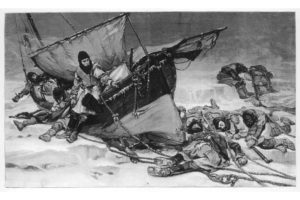
Engraving showing the end of Sir John Franklin’s ill-fated Arctic expedition of 1845 entitled ‘They Forged the last link with their lives’. This engraving was taken from a painting by W. Thomas Smith exhibited in the Royal Academy in 1896. PHOTO: MARY EVANS/ILLUSTRATED LONDON NEWS LTDT/EVERETT COLLECTION
Earlier this month, searchers found the HMS Terror beneath the Canadian Arctic ice, solving one of the most famous mysteries in maritime history. The ship was part of an expedition led by Sir John Franklin that vanished in the 1840s while trying to locate the Northwest Passage.
The disappearance inspired more than 50 search expeditions, as well as an outpouring of literature. Charles Dickens had a major hand in a stage production about the disaster, and an elegy by the poet Algernon Swinburne, “The Death of Sir John Franklin,” asked poignantly, “Is this the end?” Continue reading…











 The Tale of Genji
The Tale of Genji

